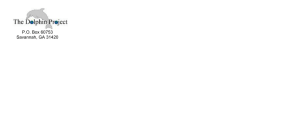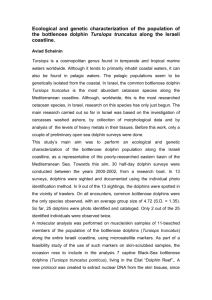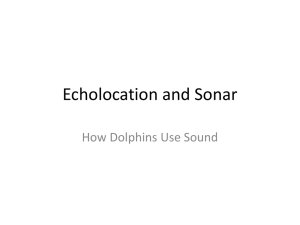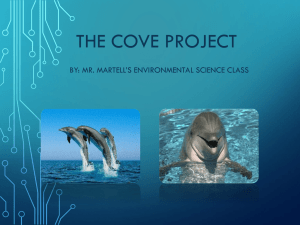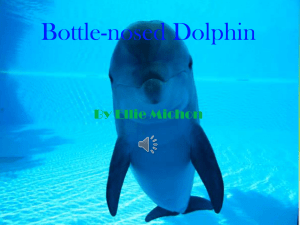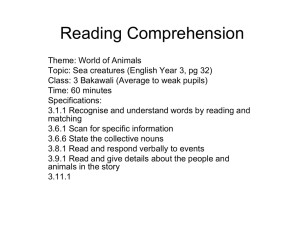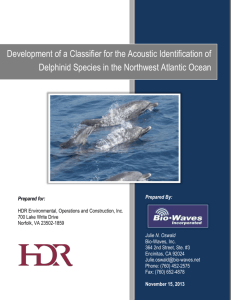Dolphin Tale Worksheet How is the video Dolphin Tale related to
advertisement
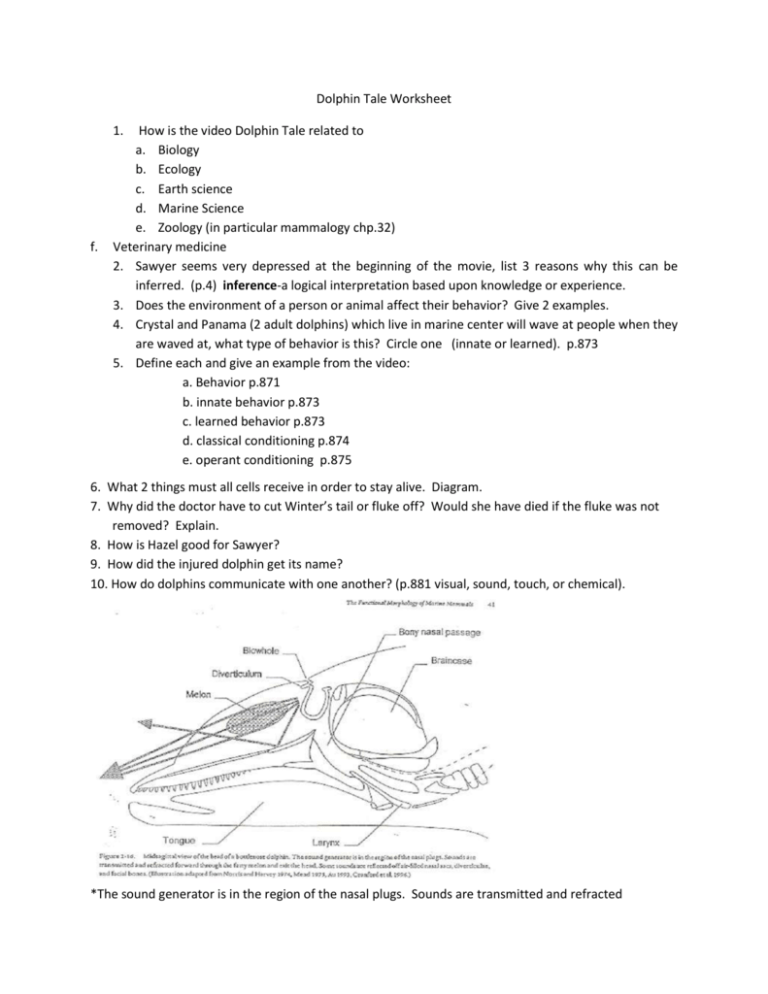
Dolphin Tale Worksheet 1. f. How is the video Dolphin Tale related to a. Biology b. Ecology c. Earth science d. Marine Science e. Zoology (in particular mammalogy chp.32) Veterinary medicine 2. Sawyer seems very depressed at the beginning of the movie, list 3 reasons why this can be inferred. (p.4) inference-a logical interpretation based upon knowledge or experience. 3. Does the environment of a person or animal affect their behavior? Give 2 examples. 4. Crystal and Panama (2 adult dolphins) which live in marine center will wave at people when they are waved at, what type of behavior is this? Circle one (innate or learned). p.873 5. Define each and give an example from the video: a. Behavior p.871 b. innate behavior p.873 c. learned behavior p.873 d. classical conditioning p.874 e. operant conditioning p.875 6. What 2 things must all cells receive in order to stay alive. Diagram. 7. Why did the doctor have to cut Winter’s tail or fluke off? Would she have died if the fluke was not removed? Explain. 8. How is Hazel good for Sawyer? 9. How did the injured dolphin get its name? 10. How do dolphins communicate with one another? (p.881 visual, sound, touch, or chemical). *The sound generator is in the region of the nasal plugs. Sounds are transmitted and refracted Forward through the fatty melon and exit the head. Some sounds are reflected off air-filled nasal sacs, diverticulum, and facial bones. Color code the tongue pink / color code the melon yellow / color code the braincase blue 10. How does Sawyer get Winter to drink her bottle milk? 11. When Winter nursed from her mother or drank her milk bottle she used a sucking reflex. What type of behavior is this? Circle one (innate or learned). 12. Want type of organism is Rufus? How about Fred?________________, __________________ 13. How do dolphins find food? Panama has lost hers.________________________________ *Dolphins produce directional clicks in trains. The click trains pass through the melon (the rounded region of a dolphin's forehead), which consists of lipids (fats). The melon acts as an acoustical lens to focus these sound waves into a beam, which is projected forward into water in front of the animal. These sound waves bounce off objects in the water and return to the dolphin in the form of an echo. The major areas of sound reception are the fat-filled cavities of the lower jaw bones. Sounds are received and conducted through the lower jaw to the middle ear, inner ear, and then to hearing centers in the brain via the auditory nerve. The brain receives the sound waves in the form of nerve impulses, which relay the messages of sound and enable the dolphin to interpret the sound's meaning. By this complex system of echolocation dolphins can determine size, shape, speed, distance, direction, and even some of the internal structure of objects in the water. 14. Why is sound in the dark, sometimes murky waters of the sea important to animals like dolphins? 15. Sawyer has a connection with animals that allows him to communicate with them. Explain. 16. Why should fishermen and others not leave their old crab pots, hooks, trash, etc. in the ocean? 17. How does trash in ocean affect sea life? Give 4 examples. 18. If you had the opportunity would like to touch or swim with dolphins. 19. Should Marine Mammals be kept in captivity? Are there some instances when captivity is a good solution and other instances when it is not? Explain. P.853 20. Role-Playing : Suppose you are a wildlife biologist managing a declining population of wild bottlenose dolphins. (You need to learn about the lifestyle of this dolphin before you can recommend any solutions. You also want to increase public awareness to help protect the population. Write a proposal on how you will do all this). Read page 853 21. Why are the board members of Clearwater Marine Hospital considering selling? 22. Why is it incorrect to say a dolphin is a fish? p.771 23. What are the characteristics of mammals? p.821 24. How do mammals maintain homeostasis? p. 822 25. How old is Winter? Hint: calves nurse up to 18 months, Sawyer was feeding Winter a milk mixture. 26. The milk a mother provides is 33% fat, 6.8% protein, 58.3% water, and a trace of lactose. This is a rich formula that helps the calf develop an insulative layer of __________________. 27. Female dolphins are sexually mature at 5 to 12 years of age, Males at 10 to 12 years of age. Is Winter a male or female? 28. A female can bear a calf every 2 years. A calf will be approximately 42 to 52 inches long and weigh around 44 pounds. The calf will nurse under water, close to the surface. Calves suckle from nipples concealed in abdominal mammary slits about four times every hour both night and day. Nursing last 5 to 10 seconds. Think back to the movie how many times did you see Sawyer and Hazel feeding Winter? Was it accurate? 29. Are calves born head first or fluke first? How is the umbilical cord cut? Why do the newborn calves appear to have stripes alone their sides (they go away with time)? 30. During the movie Sawyer was called “Winter’s mother now”. Why? Look up imprinting. P. 876 31. Draw a food chain for a mature bottlenose dolphin. P. 69 and p. 823 32. Dolphins are considered predators. Explain where they would be on a food chain (beginning or end)? 33. Are dolphins consumers or producers? Heterotrophs or autotrophs? Carnivores, herbivores, or Omnivores? Circle or underline your choices. 34. Circle the physical adaptations of a dolphin that enables it to swim (below). Box the physical adaptation that enables the dolphin to breath. 35. What type of ecosystem do dolphins live in? pp.106, 109 ____________________________ 36. When you see a dolphin breaching (jumping out of the water and landing on their sides) are they In the photic or aphotic zone? (look on your prefix/suffix sheet to define photo- and a- ) 37. What factor is absent in the aphotic zone? P.109 38. As mammals evolved, the form and function of their jaws and teeth became __________________ to eat foods other than insects. The joint between the skull and lower jaw became____________ than that of reptiles. This joint allowed mammals to ________________ larger, more powerful jaw ________________ and different ways of chewing. p.822 39. Bottlenose dolphins do not chew however. They swallow their food whole, head first, they break large fish by shaking them. So what is their lower jawbone used for? Describe their teeth. 40. Compare the body movement for swimming in a fish and a dolphin. 41. How did Winter overcome the obstacle of swimming with no fluke? How did this become a health concern? 42. A dolphin’s spinal cord is like a human’s spinal cord in that it controls __________________, __________________________, __________________, and _____________________. 43. State Problem #1(concerning Q. 41) ____________________________________________ ________________________________________________________________________. 44. Usually we observe sometime that gets our mind working so we can creatively solve problems What did Sawyer see at the VA hospital that got his mind thinking about how to help Winter? 45. Give the hypothesis the prosthetist can up with? ________________________________ ______________________________________________________________________ 46. Together the marine biologist (Hazel’s dad) and the prosthetist man, plus Sawyer, Hazel, and others had to learn all they could about the mechanics of a dolphins movement and fluke. Look at the 2 pictures above in Q. 41, describe the mechanicals of the keel muscles (picture Q. 34) in order to move the fluke. 47. What is the name of the step in the scientific method described in #46, in bold print? 48. Design the design of the first prosthetic fluke. (Experiment) 49. Part of the experiment was the actual testing of the prosthetic fluke on Winter. Describe the outcome or observation made. (dependent variable) 50. Can you identify the control, independent variable of experiment #1? 51. Did the team (prosthetist, marine biologist, Sawyer, and Hazel) give up on Winter and solving her Problem? 52. Do we change the problem or the hypothesis and try again?___________________


